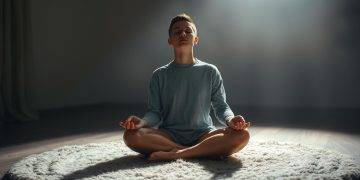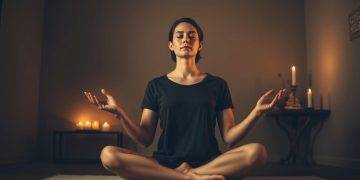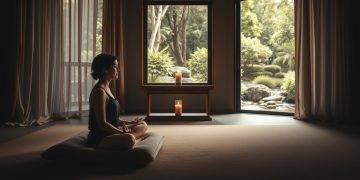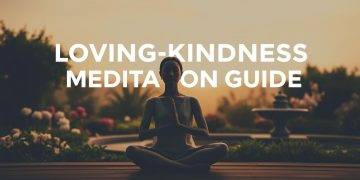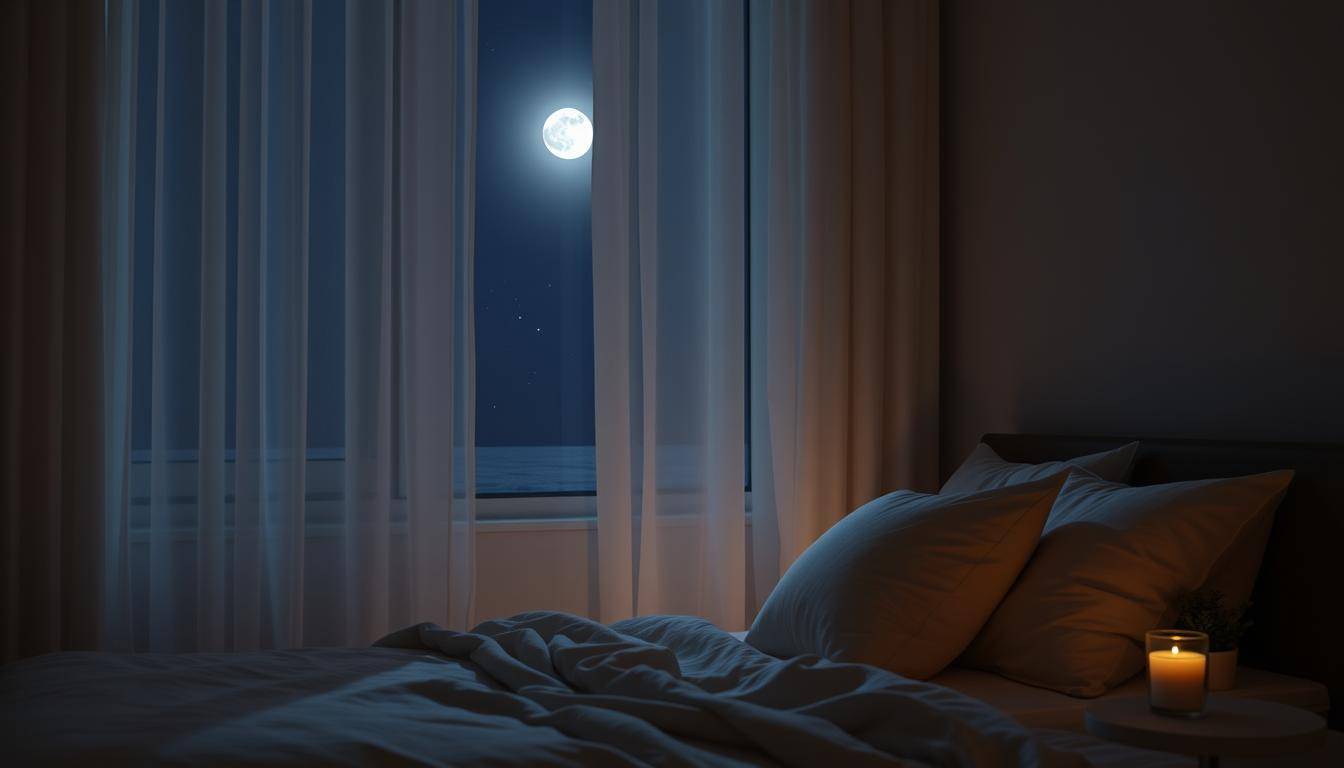“The secret of getting ahead is getting started.” – Mark Twain
Finding restful sleep in today’s world can feel like a dream. But, there’s a simple way to beat anxiety and sleep better. Guided sleep meditation is a powerful tool that can help you sleep deeply and wake up feeling refreshed.
Anxiety can make it hard to sleep, keeping you awake all night. But, with the right methods, you can overcome this. Guided sleep meditation uses breathing, muscle relaxation, and positive thoughts to calm your mind. It helps you relax deeply and sleep well.
Key Takeaways
- Guided sleep meditation combines breathing exercises, muscle relaxation, and positive affirmations to promote deep relaxation and better sleep.
- This practice can help reduce anxiety and stress, enabling you to fall asleep more easily and enjoy more restful, uninterrupted sleep.
- Consistent practice of guided sleep meditation can lead to long-term improvements in sleep quality and overall well-being.
- The meditation is suitable for individuals of all experience levels, making it an accessible and user-friendly option for anyone seeking better sleep.
- Incorporating guided sleep meditation into your nightly routine can be a powerful tool in your journey to overcome insomnia and achieve the peaceful, rejuvenating sleep you deserve.
Understanding the Connection Between Sleep and Anxiety
The link between sleep and anxiety is complex. Anxiety can make it hard to fall asleep or stay asleep. It often leads to racing thoughts and restlessness, making it tough to get a good night’s sleep.
How Anxiety Affects Your Sleep Cycle
Anxiety can mess up your sleep-wake cycle. It creates a cycle of poor sleep and more anxiety. When you’re anxious, your body’s stress response goes up, causing adrenaline and cortisol to surge.
This makes it hard for your mind and body to relax. It’s tough to fall asleep and stay asleep through the night.
The Science Behind Sleep-Related Anxiety
Anxiety disorders are common in the U.S., affecting about 20% of adults. Almost 50% of people with depression also have an anxiety disorder. The connection between anxiety and sleep is clear, with over 90% of military combat PTSD sufferers experiencing insomnia.
Common Triggers and Symptoms
- Work-related stress
- Relationship issues
- Health concerns
- Increased heart rate
- Muscle tension
- Intrusive thoughts
Understanding the connection between sleep and anxiety is key. By knowing the common triggers and symptoms, you can take steps to improve your sleep and reduce anxiety.
The Power of Guided Sleep Meditation Anxiety Techniques
Having trouble sleeping because of anxiety? Guided sleep meditation might be the answer you need. It connects your mind and body, helping you relax and sleep better.
These meditations use calming images, gentle words, and deep relaxation techniques. They create a peaceful space that relaxes both your mind and body. This can greatly improve your sleep and overall health.
Studies show that mindfulness meditation can help with sleep and reduce insomnia, especially in college students. Guided sleep meditations by experts like Jason Stephenson have over 1 billion views on YouTube. This shows how popular and effective they are.
Whether you have trouble sleeping sometimes or all the time, trying guided sleep meditation can change your life. So, why not give it a shot and see how it can help you?
“Meditation emphasizes focused attention, relaxed breathing, a quiet setting, a comfortable position, and an open attitude to facilitate stress reduction and overall well-being.” – [Expert Source]

Guided sleep meditation offers many options, from soothing sounds to calming words. You can find the right one for you to help you sleep peacefully, leaving anxiety behind.
So, why not try guided sleep meditation tonight? Your mind and body will appreciate the calm and refreshment it brings.
Essential Components of Sleep Meditation Practice
Setting up the right space for sleep meditation is key for deep relaxation and restful sleep. Dim the lights and remove distractions. Make sure the room is at a comfortable temperature. The best time for meditation is before bed or during nighttime wake-ups, when your body is ready for sleep.
Choosing the right body position is also important. You can lie down in bed or sit comfortably. Focus on a position that lets you fully relax and be in the moment. Adding mindfulness exercises and calming visualization can make your meditation better and help you relax more.
Creating the Perfect Environment
- Dim the lights to create a soothing, sleep-friendly atmosphere.
- Eliminate any potential distractions, such as electronic devices or loud noises.
- Ensure the room temperature is comfortable, typically between 65-70°F (18-21°C).
Optimal Timing for Meditation
The best time for sleep meditation is before bed or during nighttime wake-ups. This matches your natural sleep cycle and helps you fall asleep easier.
Body Position and Comfort
Choose a comfortable position, whether lying in bed or sitting. Try different positions to find what works best for you. Make sure your body is supported so you can relax fully.
“Meditation is not about getting anywhere else, but about being where you already are and knowing it for the first time.” – Jon Kabat-Zinn
| Technique | Benefits |
|---|---|
| Mindfulness Exercises | Enhance present-moment awareness, reduce rumination, and promote relaxation. |
| Calming Visualization | Engage the imagination to create soothing mental imagery, reducing stress and anxiety. |
By setting up the right space, timing your meditation, and choosing a comfortable position, you’re ready for a restful sleep meditation. Using mindfulness exercises and calming visualization can make your experience even better and help you sleep peacefully.
Deep Breathing Exercises for Peaceful Sleep
Getting a good night’s sleep can be hard when anxiety is high. But, deep breathing exercises can help. They can reduce stress and anxiety, making it easier to sleep well.
The 4-7-8 technique is a well-known deep breathing exercise. It involves inhaling for four counts, holding for seven, and exhaling for eight. Doing this for a few minutes before bed can slow your heart rate and calm your mind, helping you sleep.
Diaphragmatic or “belly” breathing is another good exercise. It makes your belly go up and down with your breath. Studies show it can relax you, making it easier to fall asleep.
To add deep breathing to your bedtime routine, find a quiet spot. Focus on the air moving in and out of your body. Try different techniques to see what works best for you.
| Deep Breathing Exercise | Benefits for Sleep |
|---|---|
| 4-7-8 Technique | Slows heart rate, lowers blood pressure, calms racing thoughts |
| Diaphragmatic Breathing | Induces relaxation, eases transition into sleep |
| Yoga Nidra | Promotes calmness and improved sleep quality |
Adding deep breathing to your bedtime routine can help you sleep better. It can reduce anxiety’s impact on your sleep. Try different techniques to find what works best for you and enjoy better sleep.
Progressive Muscle Relaxation Techniques
If you’re looking for ways to relax and reduce anxiety, try progressive muscle relaxation (PMR). This method helps both your body and mind. It involves tensing and then releasing muscles to achieve deep calm.
Step-by-Step Relaxation Guide
PMR takes about 15 minutes. Here’s how to do it:
- Begin with your feet and toes. Tense the muscles for 5 seconds, then relax.
- Move up to your calves, thighs, and hips. Repeat the tensing and releasing.
- Keep going through your abdomen, back, chest, shoulders, and arms. Breathe deeply.
- End with your neck and facial muscles. Gently squeeze and then release.
Common Mistakes to Avoid
Avoid tensing too hard or rushing. Focus on each part and feel the difference. Also, skip any painful areas to avoid discomfort.
Benefits for Anxiety Relief
PMR can greatly help with anxiety. It relaxes muscles, lowers stress hormones, and improves body awareness. This connection helps you notice and manage anxiety better.
Using PMR before bed can also help with sleep anxiety. It leads to a calmer night and better sleep.
Mindfulness and Visualization Practices
Mindfulness and visualization are great tools for guided sleep meditation. They help you stay in the present moment. This lets go of worries about the past or future.
Visualization often means picturing peaceful scenes or positive outcomes. This can greatly reduce anxiety and help you relax deeply.
Mindfulness exercises, like body scans or breath awareness, focus on your senses now. They help quiet the mental chatter that keeps you awake. Regular practice can improve your sleep by calming your mind and easing anxiety.
Calming Visualization Exercises
Guided imagery and visualization can help you sleep better. Start by thinking of a pleasant memory, like a serene nature scene or a favorite vacation spot. Immerse yourself in the details of this calm place.
As you breathe deeply, let tension leave your body. You can also imagine waking up feeling rested and refreshed. Picture yourself falling asleep easily and waking up calm and clear.
Mindfulness Exercises for Sleep
- Body Scan: Relax each muscle group, from toes to head.
- Breath Awareness: Focus on your breathing to soothe you.
- Sensory Awareness: Notice your surroundings to ground you in the present.
Being consistent and regular is important for these techniques to work well. With effort, you can use the present moment to get the sleep you need.

Incorporating Calming Affirmations
Starting your guided sleep meditation journey can help you beat anxiety and insomnia. Using calming affirmations is a great way to do this. Say things like “I am calm and ready for restful sleep” to change your thoughts and relax.
These affirmations fight off the anxious thoughts that keep you up. They replace them with calm and empowering ones.
Positive Sleep Statements
- “I welcome a peaceful night’s sleep.”
- “My mind and body are at ease as I drift off to sleep.”
- “I am safe and secure in my resting place.”
- “I release any worries or stress, allowing myself to fully relax.”
Self-Compassion Techniques
Self-compassion is also key for those with guided sleep meditation anxiety or insomnia. It’s about being kind and understanding to yourself, not harsh. This can lower anxiety and make sleep better by creating a caring inner voice.
“When we are kind and compassionate with ourselves, we are more likely to experience a sense of calm and well-being, which can lead to more restful and rejuvenating sleep.” – Dr. Kristin Neff, Self-Compassion Researcher
By adding positive sleep affirmations and self-compassion to your meditation, you get a strong tool. It helps you naturally overcome insomnia and get the sleep you need.
Building a Consistent Bedtime Meditation Routine
Creating a bedtime meditation routine is crucial for a good night’s sleep. It helps you overcome insomnia naturally. Start by setting a specific time each night for meditation. Make sure you have a special spot in your bedroom for it.
Choose guided meditations or techniques that feel right to you. Consistency trains your mind and body for sleep. A regular routine can improve your sleep, reduce anxiety, and boost your well-being.
Try different methods like breathing exercises, body scans, or visualization. Find what works best for you. Making meditation a nightly habit is key. It sets you up for better sleep and helps you fight insomnia naturally.
By dedicating space and time to meditation, you’re on the path to peaceful sleep. Enjoy the journey and let a consistent routine lead you to restful nights.
FAQ
What is guided sleep meditation for anxiety?
Guided sleep meditation for anxiety uses focused breathing and muscle relaxation. It also includes affirmations for peace and gratitude. These methods help you relax and sleep better, leading to peaceful nights.
How does anxiety affect sleep quality?
Anxiety can make it hard to fall asleep or stay asleep. It causes racing thoughts and restlessness. Stress at work, relationship problems, and health worries are common triggers.
How can guided sleep meditation help with anxiety and sleep issues?
Guided sleep meditation calms the mind and reduces stress. It creates a peaceful atmosphere, helping you release daily worries. By using Scripture verses and soothing stories, it helps you sleep better.
What is the ideal environment for sleep meditation?
For sleep meditation, dim the lights and remove distractions. Keep the room cool and comfortable. Sit or lie down in a relaxed way. Mindfulness and visualizations can make your meditation better.
How can deep breathing exercises help with anxiety and sleep?
Deep breathing exercises are key in guided sleep meditation. They calm your body and mind. By focusing on your breath, you can slow your heart rate and relax.
What is Progressive Muscle Relaxation (PMR) and how can it help with anxiety?
PMR is a technique used in meditation. It involves tensing and relaxing muscles to relax your body and mind. It starts with your toes and goes up to your head. It helps reduce muscle tension and stress.
How do mindfulness and visualization practices benefit sleep and anxiety?
Mindfulness and visualization help you focus on the present. They reduce worries and promote relaxation. These practices can improve your sleep by calming your mind.
How can calming affirmations and self-compassion techniques improve sleep and reduce anxiety?
Calming affirmations, like “I am calm and ready for sleep,” can help you relax. Self-compassion treats you with kindness, reducing anxiety and improving sleep. These are great for insomnia or anxious thoughts at night.
Why is it important to establish a consistent bedtime meditation routine?
A consistent bedtime routine is key for long-term benefits. It trains your mind and body for sleep. Regular practice improves sleep quality, reduces anxiety, and boosts well-being.





